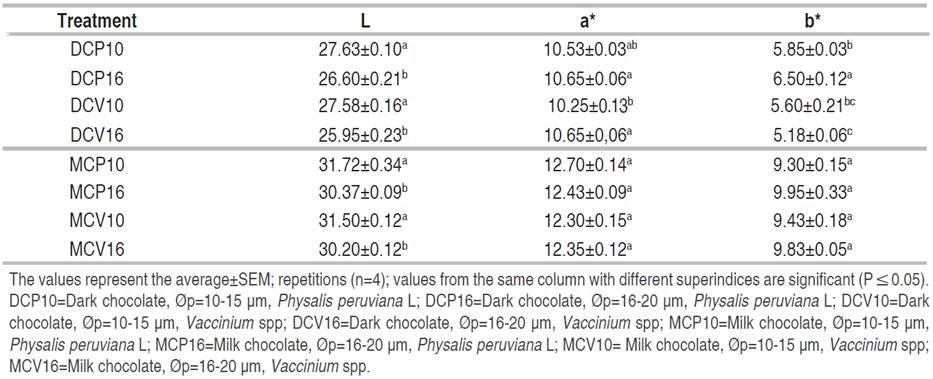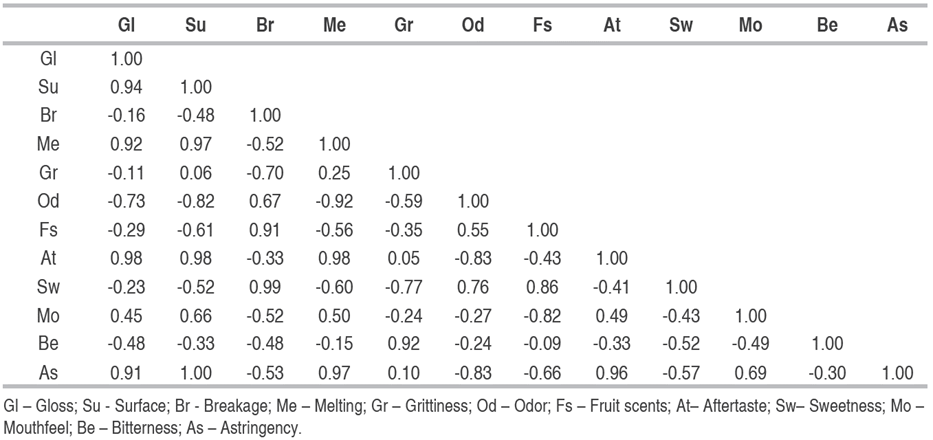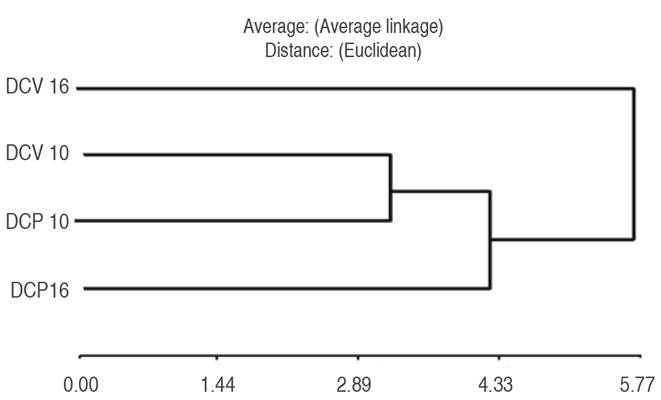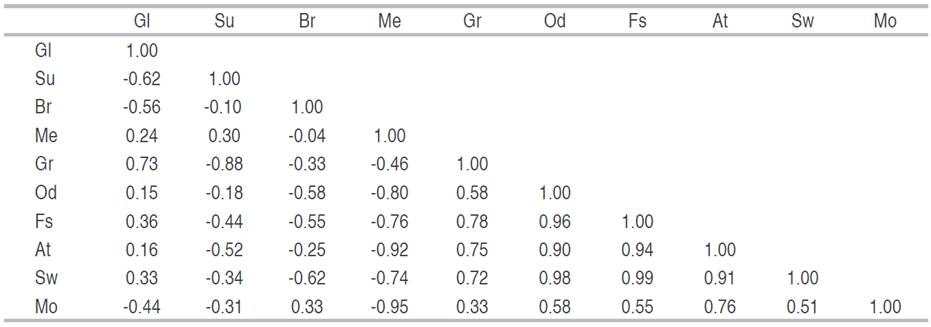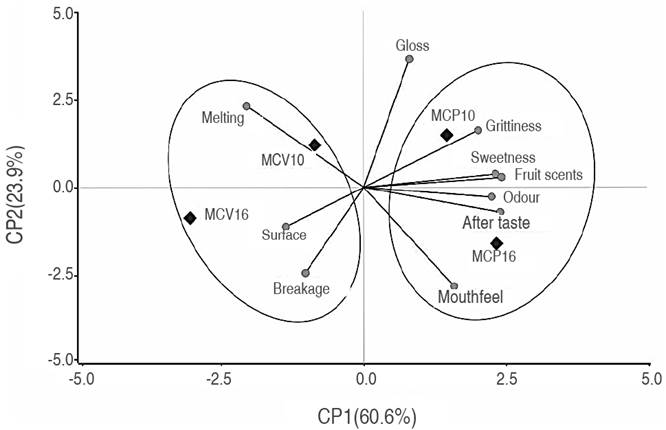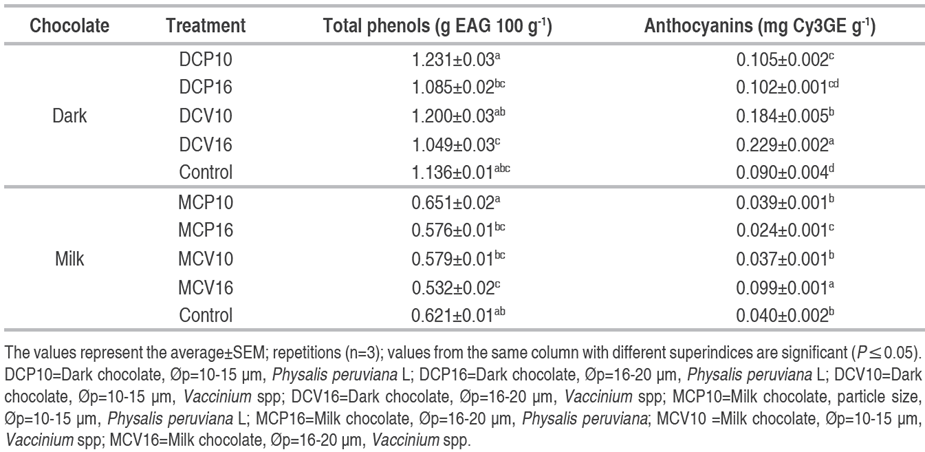Chocolate is a very popular product worldwide. Its market value has risen to 500 million dollars since 2017, with an annual growth of 5.6%, and is expected to reach an average of 730 million dollars in the world market by 2025 (Kim and Jeon 2019). Chocolate is categorized as a functional, nutraceutical food, and is consumed around the world; at the same time, it is valued for its polyphenol content because it has been demonstrated to protect the cardiovascular system due to its antioxidant activity (Deus et al. 2020). It is also considered good for increasing longevity, libido, and fertility, as well as preventing diseases such as cancer, diabetes, and others related to oxidative stress (Halib et al. 2020).
Chocolates are made with cocoa beans, which contain three groups of polyphenols: catechins or flavan-3-ols (37%), anthocyanins (4%) and proanthocyanidins (58%). Furthermore, the total phenols content in dark and milk chocolates varies depending on the proportion of cocoa solids used in formulation (Afoakwa 2016). For example, dark chocolate contains cocoa butter, a low sugar content, and high cocoa solids content. The latter affects the sensory profile, highlighting bitterness and astringency, which are related to phenol compounds that potentially influence consumers acceptance (Ostrowska-Ligęza et al. 2018).
To make chocolate, cocoa must go through a process of fermentation, drying, roasting, grinding, refining, conching, and tempering. During these operations, there is a noticeable decrease in the content of bioactive compounds. Phenolic compounds can be reduced to up to one-tenth of their original condition and some flavonoids can disappear as a result of non-enzymatic browning (Mattia et al. 2017). Anthocyanins and procyanidins are degraded by hydrolysis during the fermentation process and about 50% of epicatechin is lost in drying (Zugravu and Otelea 2019). To balance these enormous losses of phytochemicals, fortification with fruits, spices, or probiotics, is one of the most effective alternatives. This fortification can also improve the physical, rheological, and organoleptic properties of chocolates (Sharmistha et al. 2022).
Refining and conching are operations that determine the particle size distribution, consistency, and viscosity of chocolate to produce specific textural and the sensory qualities (Afoakwa 2016). The structure and size of non-fat particles in chocolates are two factors that influence sensory quality, because inhomogeneous particles give a pasty consistency and are more difficult to handle in the mouth (Tan and Balasubramanian 2017). The sensory attributes of melting, flavor, smell, and texture of chocolate are associated with roasting temperature and particle size (Hinneh et al. 2019).
Perú is very diverse in promising fruit, that develops perennially on the coast, mountain region and jungle, due to the various microclimates, peaks, and soils within the country. The fruit of the Vaccinium spp. and Physalis peruviana L. species are native to the high Andean regions and have achieved great importance due to their bioactive, functional, and mineral compounds (Bazalar et al. 2020). The goldenberry (Physalis peruviana L.) originated in the Peruvian and Ecuatorian Andes and is known as uchuva, uvilla or aguaymanto, and as goldenberry in English-speaking countries. This fruit is consumed fresh and processed. At the same time, it is valued for its organoleptic properties, nutritional value, and health benefits due to compounds such as vitamin C, carotenoids, flavonoids, and antioxidant activity (El-Beltagi et al. 2019). The Andean blueberry (Vaccinium spp.) grows wild in the Huánuco region but has no commercial value and is only consumed by those who live in the area. The Ericaceae family and the Vaccinium spp genre are widespread and represent around 40 species. The berries are dark blue in color and have delicious sensory properties as well as antioxidant and dye properties. This fruit also contains phenolic compounds (anthocyanins), sugars, fiber, lipids, and vitamins and has nutraceutical properties that act as protectors against cancer, age-related neurodegenerative diseases, and inflammatory responses (Quintero-Quiroz et al. 2019). The objective was to evaluate the effect of particle size and the inclusion of Physalis peruviana L (Goldenberry) and Vaccinium spp (Andean blueberry) on sensory attributes, color, total phenols, and anthocyanins in dark and milk chocolate.
MATERIALS AND METHODS
The different varieties of cocoa liquor from the Amazon region were obtained from the company "Agro Industrias MAKAO Perú S.A.C." The Andean blueberry fruit (Vaccinium spp.) was harvested from the Rondos district (3566 masl; 10°0'52.733" S and 76°42'53.046" W), Lauricocha province, and the goldenberries (Physalis peruviana L.) were harvested from Nauyan Rondos province of Huánuco, (2748 masl; 9°57'5.004" S; 76°14'49.885" W).
Experimental methodology
Elaboration
For the 70% dark chocolate, 65% cocoa paste, 5% cocoa butter, 29.5% sugar, and 0.5% lecithin were used. For milk chocolate, 14.5% cocoa paste, 19.5% cocoa butter, 20% milk powder, 45.5% sugar, 0.45% lecithin, and 0.05% vanilla were used. The final particle sizes (Øp) were 10-15 µm and 16-20 µm (refiner/shelling machine QYJ-20. China). Concerning the inclusions, they were 12% goldenberries (DCP10 and DCP16) and 12% Andean blueberries (DCV10 and DCV16).
Measure of color
A colorimeter (Lovibond LC-100/SV-100-United Kingdom) was used. The system used for measurements was CIELAB, gloss (L*), and chromaticity (a* and b*), with four repetitions for each sample (Chire-Fajardo et al. 2019).
The sensory evaluation
It was done following the Belščak-Cvitanović et al. (2012) method, with some modifications. The judges that were used were six with experience in tasting cocoa liquor and chocolates. For the dark chocolate, an evaluation sheet with 11 attributes was used: gloss, surface, breakage, melting, grittiness, odor, fruit scents, aftertaste, sweetness, mouthfeel, bitterness, and astringency; and for the milk chocolate, 10 attributes were used, similar to the dark chocolate, except for bitterness and astringency. The hedonic scale was five points, with one being "tasteless" and five being "extremely desirable."
Total phenols
The method proposed by Delgado et al. (2018) was followed, with some modifications. A mix of 100 µL of diluted extract (2.5 mg mL-1) with 500 µL of Folin-Ciocalteu's reagent (0.2 N) was made; later, 400 µL of sodium carbonate 7.5% (w v -1) was added. The mix was stored for two hours at room temperature and in darkness before measuring the absorbance at 740 nm in a UV-visible spectrophotometer (Genesys 150, USA). A standard curve for gallic acid was elaborated (1 to 10 µg mL-1) in order to express the absorbency of the sample as a concentration of phenols, equivalent in gallic acid (g EAG 100 g-1).
Anthocyanins: The pH differential method was followed (Zapata et al. 2014). Two distinct buffer solutions were prepared, one from KCl (0.025 M, pH=1) and sodium acetate (0.4 M, pH=4.5). For each sample, the appropriate dilution factor was determined, taking into account that the absorbance should not pass 1.2 without exceeding a 20% dilution factor, since that would surpass the saturation indices of the buffers. The maximum wavelength depends on the pattern chosen (cyanidin-3-glucoside, 510 nm). For the calculations, the following Equation (1) was used:
The molecular mass of cyanidin-3-glucoside was (MW) 449.2 g mol-1, the molar extinction coefficient was (ε) 26900 L mol-1 cm-1, and the l, the length of the optical path (1 cm).
Statistical analysis
The results were analyzed through the use of the unifactorial ANOVA, and for the treatments, where there was a statistical difference, the Tukey test (P<0.05) was applied. On the other hand, the description of the principal variation of the sensory data, obtaining the descriptive profiles, and the graph of the response in a cluster on a dendrogram were done through the quantitative descriptive analysis (QDA) and the multivariate principal component's analysis (PCA). Finally, Pearson's linear correlation was calculated using the program InfoStat 2019P, Universidad Nacional de Córdoba, Argentina.
RESULTS AND DISCUSSION
Color of the chocolates
The highest gloss (L) of the dark chocolate (Table 1) was for the Øp=10-15 µm particle size with goldenberries and Andean blueberries; the opposite case occurred for the Øp=16-20 µm size. According to the results, it can be observed that particle size affects gloss; this concurs with Hinneh et al. (2019), who mentions that the highest gloss values were for the dark chocolate with small particles, Øp=25.25±0.09 µm, and the lowest was for the large particles, Øp=27.98±0.02 µm. At the same time, Chire-Fajardo et al. (2019) obtained L=27.28±0.30 to 26.19±0.34 for dark chocolates, indicating that the gloss is affected by the factors such as formula, tempering, bean color, temperature, roasting time, and shelling. On the other hand, the highest gloss for the milk chocolate corresponded to the Øp=10-15 µm particle size with goldenberries and the lowest was for the Øp=16-20 µm particle size with Andean blueberries; the values that were reported agree with the results from Konar et al. (2018), L=31-28 for milk chocolates. It is worth mentioning that a shiny, glossy, and smooth chocolate will have greater acceptance on behalf of the consumer (Sözeri Atik et al. 2020).
The results of the a* chroma for the dark chocolate presented differences; the highest value was for the chocolates with a Øp=16-20 µm size particles with goldenberries and Andean blueberries. This result was very similar to that reported by Hinneh et al. (2019) for chocolates refined with two types of mills, which obtained values of a*=12.7±0.2 to 10.06±0.3. Meanwhile, the milk chocolates with goldenberries and Andean blueberries had a range from a* 12.30 to 12.70; these values were superior to the dark chocolate, which could be due to the fact that the solid cocoa content was lower. The a* chroma is seen to be influenced by the formula (sugar, milk, fruit, etc.), because it generates an effect of diluting the intensity of the chocolate's color. A decrease in the cocoa liquor percentage in the chocolate provokes a decrease of the dark brown color, and thus, the value of the a* chroma increases (De Jesus Silva et al. 2019).
On the other hand, the highest b* chroma for the dark chocolate was for the Øp=16-20 µm particle size with goldenberries; the positive sign indicates the presence of the color yellow; to which Etzbach et al. (2018) indicated that the goldenberry is a yellow-orange color fruit, rich in α, β carotenes and lutein. The lowest b* was presented by the chocolate with Øp=16-20 µm particle size and Andean blueberries, the fruit of which is a dark blue color, very similar to the blueberry (Quintero-Quiroz et al. 2019).
Sensory evaluation for the dark chocolate
According to the sensory profile from the descriptive quantitative analysis DQA (Figure 1), it can be observed that particle size did not affect the gloss attribute. The gloss and brown color positively influenced the acceptance of the consumer (Kiumarsi et al. 2020). The breakage was not affected by the particle size; a good breakage, gloss, texture, and melting is achieved with a good tempering, because during this operation the polymorphic changes of the cocoa butter occur (Halim et al. 2019). The melting was classified as "desirable" for the chocolates (Øp=10-15 µm) with the inclusion of goldenberries and Andean blueberries; this attribute is perceived through the level of melting when it is in contact with the hand for 30 seconds (Toker et al. 2019). The grittiness was classified as "desirable"; particle sizes superior to 30 µm tend to cause the perception of a gritty sensation in the mouth. The chocolate with the inclusion of Andean blueberries presented a better classification for the fruit scents attribute. The best mouthfeel was presented by the (Øp=10-15 and 16-20 µm) chocolates with goldenberries; this attribute is related to the texture of the chocolate and is evaluated using the terms stickiness, grittiness, dryness, creaminess, and coating (De Pelsmaeker et al. 2019). The bitterness was classified as "adequate", and the astringency as "desirable"; these classifications were due to the presence of the polyphenols in the cocoa beans. It is worth highlighting that the chocolate with a Øp=16-20 µm particle size with the inclusion of Andean blueberries was classified as "tolerable" with respect to the astringency. Lin et al. (2020) indicated that blueberries present astringency, due to the presence of proline with tannins and phenolic compounds.
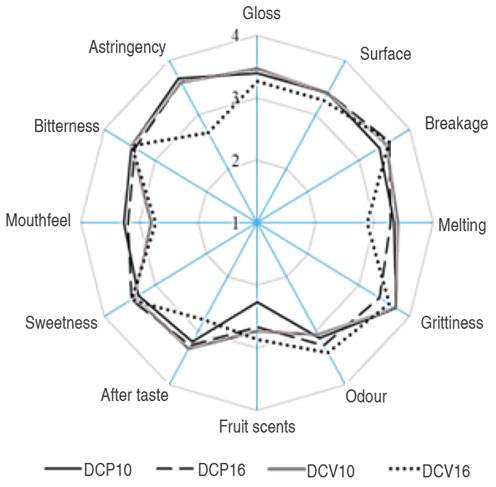
Figure 1 Sensory profile of dark chocolate. DCP10=Dark chocolate, Øp=10-15 µm, Physalis peruviana L; DCP16=Dark chocolate, Øp=16-20 µm, Physalis peruviana L; DCV10=Dark chocolate, Øp=10-15 µm, Vaccinium spp; DCV16=Dark chocolate, Øp=16-20 µm, Vaccinium spp.
According to the correlation matrix between the tasting attributes of the dark chocolates (Table 2), the "gloss" attribute presented a high correlation between the surface, melting, aftertaste, and astringency. The surface was correlated with the melting, aftertaste, and astringency; with values of 0.97, 0.98 and 1.0, respectively. To this effect, De Pelsmaeker et al. (2019) indicated that the melting depends on the textural properties (cohesion, consistency, hardness, and surface). The melting vs. the odor had a correlation of -0.92; this behavior was similar to that reported by Muhammad et al. (2018), the chocolate with cinnamon particles significantly affected the melting profile.
The behavior of the principal components analysis (PCA) biplot (Figure 2) for the dark chocolate was divided into two dimensions and explains the general variance at 87.9% of the total variability for the data between the CP1 and CP2. For the CP1 it can be observed that the grittiness attribute stood out for the chocolates with a particle size of Øp=10-15 µm, with goldenberries and Andean blueberries. For the CP2, it can be observed that the bitterness attribute stood out and was associated with the chocolate with Andean blueberries with a particle size of Øp=16-20 µm. The bitterness possibly stood out because the Andean blueberry is an edible berry with an astringent and acidic flavor, which presents a high antioxidant capacity and varieties of bioactive phenolic compounds (Garzón et al. 2020).
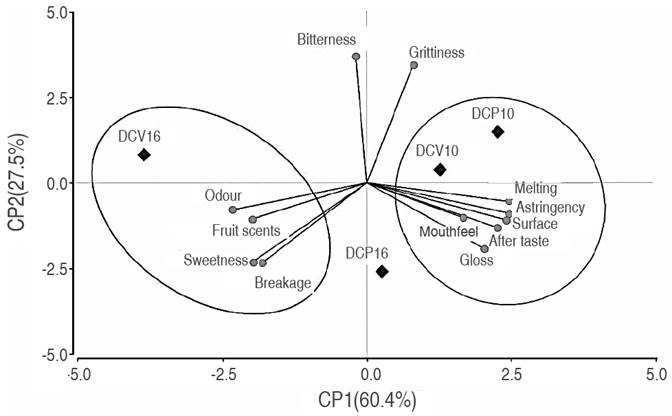
Figure 2 Behavior of the biplot of the sensory evaluation for dark chocolate. DCP10=Dark chocolate, Øp=10-15 µm, Physalis peruviana L; DCP16=Dark chocolate, Øp=16-20 µm, Physalis peruviana L; DCV10=Dark chocolate, Øp=10-15 µm, Vaccinium spp; DCV16=Dark chocolate, Øp=16-20 µm, Vaccinium spp.
According to the analysis of the dendrogram (Figure 3), two groups can be observed. The first considers just the chocolate with Andean blueberries and a particle size of Øp=16-20 µm, which had only five attributes that stood out and one of them was astringency. To this effect, Mirković et al. (2018) indicated that the volatile acids and polyphenols are responsible for the astringency in the chocolates. The second was made up of chocolates between Øp=10-15 µm with goldenberries and Andean blueberries and Øp=16-20 µm with goldenberries. This group had better classifications in the attributes of gloss, mouthfeel, aftertaste, surface, astringency, and melting.
Sensory evaluation for the milk chocolate
The chocolates had a classification of "desirable" for the attributes of gloss, surface, and breakage (Figure 4). The shelling process promotes the coating of the solid cocoa particles with the butter, developing good textural properties (Toker et al. 2019). The melting of the chocolate with Andean blueberries, for both particle sizes, presented the greatest score against the chocolate with goldenberries; given that the melting depends on the nature of the fatty acids present in the chocolate. To this effect, Handiati et al. (2019) indicated that a soft texture and good melting in the mouth are provided by the stearic (34%), palmitic (27%) and oleic (34%) fatty acids. All the chocolates were classified as "acceptable" with respect to the grittiness. The greatest score for the odor was for the chocolates with goldenberries; very fine particles allow for the volatile components to provide a strong impression of the chocolate odor (Nurhayati et al. 2019). The fruit scents attributed in the chocolates with goldenberries were superior to those with Andean blueberries due to the fact that the goldenberry has a bittersweet flavor with a pleasant aroma. For the sweetness, differences were presented with respect to the fruit that was added, but not with respect to the particle size, thus, the chocolates with goldenberries were better than those with Andean blueberries. This could be due to the fact that the goldenberry is a fruit with good acidity and easy to mask with the addition of sugar (Bazalar et al. 2020). All the chocolates were classified as "acceptable" for the mouthfeel attribute. To this respect, Hinneh et al. (2020) mentioned that the mouthfeel is perceptible when the chocolates surpass a particle size of 35 µm.
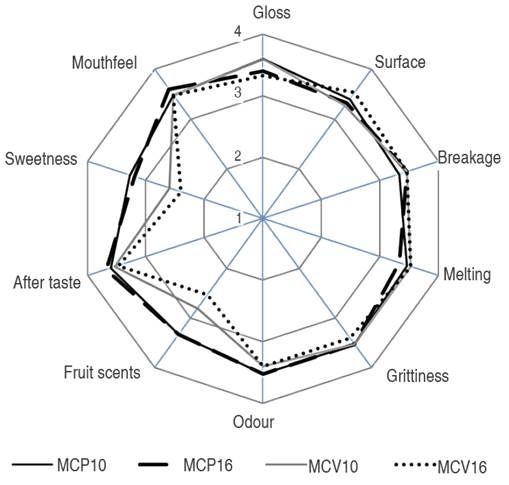
Figure 4 Sensory profile of milk chocolate. MCP10=Milk chocolate, Øp=10-15 µm, Physalis peruviana L; MCP16=Milk chocolate, Øp=16-20 µm, Physalis peruviana L; MCV10=Milk chocolate, Øp=10-15 µm, Vaccinium spp; MCV16=Milk chocolate, Øp=16-20 µm, Vaccinium spp.
According to the correlation matrix (Table 3) between the tasting attributes for the chocolates, the melting vs. aftertaste (-0.92) and the mouthfeel (-0.95) concurs with the studies done by Rosales et al. (2018), where it was found that the mouthfeel and the melting velocity are negatively correlated -0.87. This indicates that the addition of products to the chocolate mix will have an effect on the behavior of the melting of the fats and the final product. The odor was positively correlated to the fruit scents and the sweetness. To this affect, Augusto et al. (2019) indicated that the cocoa beans, when roasted, develop aromatic compounds.
The primary component (CP1) for the biplot of the milk chocolate tasting (Figure 5) were the attributes of fruit scents, sweetness, grittiness, and gloss. These were positively associated with the goldenberry and the Øp=10-15 µm size, which represents 60.6% of the total variability. The sweetness attribute is highly related to the inclusion of goldenberries and negatively related to that of the Andean blueberries. According to Delgado et al. (2018), the polyphenols are highly related to the astringency and bitterness of the chocolates. At the same time, the melting, surface, and breakage attributes of the chocolates represent 23.9% of the variability of the second component (CP2), and in general both components represent 84.5% of the total variability. The results for the CP2 show that the chocolate with Andean blueberries and a particle size of 16-20 µm was associated with the surface and breakage attributes, but not with the attributes of gloss, grittiness, sweetness, and fruit scents.
Total phenols in the dark and milk chocolates
The phenols for the dark chocolates (Table 4) varied between 1.049±0.03 and 1.231±0.03 g EAG 100 g-1. These chocolates presented significantly high phenolic compounds, which are attributed to the phenolic fraction of the cocoa beans and depend on the percentage of cocoa liquor employed in the elaboration. At the same time, the results obtained were similar to those reported by Martini et al. (2018) in dark chocolates with 70% liquor. The total phenols were greater for the Øp=10-15 µm particle size when compared to the Øp=16-20 µm particle size, for both fruits. This behavior was similar to the studies done by Nurhayati et al. (2019) with dark chocolate coverings. On the other hand, the total phenols for the milk chocolate were less in comparison to the dark; this is possibly due to the fact they have a lower content of cocoa solids.
The anthocyanin concentrations of the dark chocolates (Table 4) were Andean blueberries>goldenberries>control without fruit. The results show that the goldenberries and the Andean blueberries increased the concentration of anthocyanins in comparison to the control. In the studies done by Calva-Estrada et al. (2020), it was reported that the anthocyanin content was 0.04-0.08 mg Cy3GE g-1 in a sample of five commercial brands of dark chocolate produced in different geographic zones, with different varieties of cocoa, and different percentages of cocoa solids. The concentration of anthocyanins in the milk chocolates was between 0.024 and 0.099 mg Cy3GE g-1 for the sample; the greatest concentration was for the Øp=16-20 size with Andean blueberries; this could be due to the purple color of the fruit and to the high phenol content associated with the antioxidant activity.
CONCLUSIONS
The sensory attributes in dark and milk chocolates improved at particle sizes of 10-15 µm, being brightness, the favorable attribute for both cases. The incorporation of Physalis peruviana L, improved sensory acceptance in the attributes of fruit aroma, sweetness, grittiness, smell, aftertaste, and mouthfeel compared to Vaccinium spp. In the bioactive compounds evaluated, the addition of Vaccinium spp increased the anthocyanin content, however, it produced a decrease in sensory acceptance due to its relationship with increased astringency. A particle size of 10-15 µm improved luminosity L* in color evaluation, however berry addition influenced chromatic coordinates a* with Physalis peruviana L and b* with vaccinium spp, possibly due to the contribution of orange and purple pigments respectively. It is necessary to study new formulations and drying conditions of berries that can minimize losses of their bioactive compounds.















